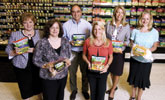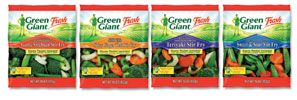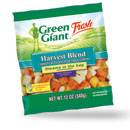
Sholl Group II leverages the popular ad icon for nationally distributed fresh-cut vegetables and other produce.

The new design for Sholl's steam-in-the-bag products better leverages the Green Giant name and image.
Rated the No. 3 commercial mascot of all time by Advertising Age magazine, the Green Giant is most familiar to consumers through its use by General Mills for frozen and canned vegetables (and some other products). But the emerald icon has another incarnation: on the packaging of fresh-cut vegetables marketed across the country by Sholl Group II.
Headquartered in Minneapolis (as is General Mills), Sholl Group II was started in 1995 by Jeffrey Sholl, who had served as senior vice president of marketing and operations for Pillsbury’s Häagen Dazs ice cream business. Pillsbury, a few years before its 2001 acquisition by General Mills, had introduced bagged salads and other fresh-cut vegetables to the market under the Green Giant name. But Pillsbury, and later General Mills, never worked up much enthusiasm for the fresh-cut vegetable business, mostly because the market had yet to develop.
“It was quite successful, but I don’t think Pillsbury was quite ready for it,” says Darci Eckermann, Sholl Group II’s senior vice president. “Green Giant Fresh and that particular product [bagged salads] was a little bit ahead of its time. So they didn’t move any further with it.”
So Jeffrey Sholl licensed the rights to use the Green Giant name for fresh vegetables in 1994, starting Sholl Group II in 1995. (A sister company, Potandon, markets fresh potatoes and onions for retail. Potandon is the largest marketer of fresh potatoes in North America.)
“Jeff felt so strongly, and was so passionate about the Green Giant Fresh brand and what a great business opportunity it would be, that he worked with the executives at Pillsbury and was able to work through a licensing agreement, giving Jeff a 25-year license for the Green Giant Fresh brand,” Eckermann says. Sholl remains the company’s president and CEO.

The new design for Sholl's steam-in-the-bag products better leverages the Green Giant name and image.
Levels of involvement
Sholl Group II operates on two basic levels. On one tier, it licenses the Green Giant name to more than a dozen grower-packers across the country for a variety of commodity fruits and vegetables such as carrots, cauliflower, strawberries and melons. Sholl’s involvement with this operation includes specifying and designing packaging, obtaining General Mills approvals, designing and managing cross promotions, headquarters sales calls and inspecting their growing and packaging operations. These licensees are responsible for procuring packaging themselves, within Sholl’s guidelines.The second tier comprises value-added Green Giant products. Sholl is more intensely engaged with these products, developing the formulations and the packaging, procuring the packaging and overseeing the operations of the five co-packers across the country who do the actual processing and packaging.
The value-added products fall into three lines: (1) Green Giant Fresh-steam line with sauce (which recently changed from Freshtables), vegetables plus “pucks” of cheese sauce or seasoned butter, meant to be steamed inside the bag in the microwave; (2) Stir-Fries, vegetable combos plus packets of sauce, that the consumer cooks in a skillet; and (3) Fresh Cut Vegetables, both individual vegetables and medleys, that can be consumed raw or cooked. They include broccoli, squash, carrots, cauliflower, green beans, snap peas and more.
Bagged salads have come into their own since Pillsbury introduced them under the Green Giant name in the early 1990s. Educating consumers on the benefits of the Green Giant Fresh line of vegetables is an ongoing task, Sholl executives say.
“There certainly is interest by consumers in these new items, but they also aren’t necessarily quite sure how to use them or where that fits into their food needs for their family,” says Jo Gruber, director of strategic business and product development. “Most often, because they’re so busy, they don’t have time to figure it out. I think that as innovators in the produce category, our charge is to provide them with new items that they desire in a way that makes it easy and safe, and offers a value to them.”
Gruber notes that bagged salads took some time to find their way into consumer consciousness, which is partly why General Mills was willing to license the business.
“As we saw what happened in the bagged salad industry, that took a while for that to fit into consumers’ lives and become part of their grocery shopping list for the week,” she says. “We fully expect that to be the same path that we see in the value-enhanced portion of produce. And so we’re looking to work closely with our retailers to help them understand that we need to build this together, and there needs to be some patience applied to reap the benefits.”
Head of steam
From a packaging standpoint, Sholl’s most significant innovation is the Freshtables line, which recently changed to Green Giant Fresh-steam line with sauce. This line was introduced last year, as the first fresh vegetables with steam-in-bag packaging.“As heat is generated in the microwave, it releases at just the exact moment so that it steams those vegetables perfectly, and provides you with the great texture, that great flavor, that wonderful vibrant color, that everyone is looking for when they’re thinking about fresh produce,” Gruber says. Consumers were familiar with the concept from numerous frozen vegetables and other frozen products with steam-in-package formats, she said; Sholl hopes to leverage that into the fresh produce aisle.
When Sholl brought out Freshtables in June 2007, settling on a packaging technology was a major challenge.
“There’s a lot of interest in the industry in venting technology,” says Dennis Lonergan, Sholl’s vice president for science and technology. “A lot of claims are made about why one vent is better than somebody else’s vent. We did a lot of work from an engineering standpoint on what is really going on during heating and during venting.”
There were a number of competing technologies, but the basic question Sholl had to settle was: how would the steam emerge from the package? They had already settled on microperforations as the best option for the film for shelf life; should the steam be vented through the microperforations, or through a dedicated aperture? Sholl decided on the latter.
“If you reply on the microperfs to vent, you are putting two constraints on the microperforations,” Lonergan says. “One is that they vent properly; the other is that they control the atmosphere in the package to improve the quality and extend the shelf life of the vegetables. So you usually have to compromise between those two. You can’t have your cake and eat it too.”
The package Sholl settled on uses a hole covered by a flap that is held in place with a special adhesive. When the microwave runs, the adhesive melts allowing the flap to open and vent steam.

The new packaging design establishes brand identity through logos while using color to maintain line unity and ease of identification.
Holes or no holes?
Another fundamental decision had to do with the nature of the packaging film itself. What was the better way to attain optimal gas and vapor transmission for a given product: microperforations, or the use of materials with inherent transmission rates?Sholl opted mostly for the former, says Art Davis, Sholl’s vice president for operations. With high-respiration products like broccoli, microperforations carry the potential for keeping more oxygen in the package. For products intended to be microwaved in the package, the most common film is 48-gauge polyester laminated to coextruded polypropylene; for non-microwaved products, an oriented PP/low-density polyethylene laminate.
Products that combine different vegetables, like stir-fries and medleys, present a unique challenge in setting respiration rates. The main concern, Davis says, is to set a weighted average that takes all the vegetables into account, while taking care not to let the package go anaerobic (depleted of oxygen), allowing spoilage microorganisms to flourish. That means the film has to be engineered to accommodate the component that absorbs the most oxygen.
Suppliers as sources
When it comes to package engineering, Sholl uses information from all available sources: in-house and third-party research, existing published research and supplier expertise. Lately, suppliers have been the most common info source, as Sholl has built a network of partners who can be trusted to take a product sample and recommend film with the characteristics needed.The film for Green Giant products gets used by one of five co-packers, stretching from Maine to California, that are responsible for all of Sholl’s production. It comes in both premade bags and rollstock film, depending on whether the co-packer hand-packs Green Giant products or uses vertical form-fill-seal (VFFS) equipment.
That, in turn, depends on how much volume an individual co-packer does for Sholl. The five co-packers that handle Green Giant value-added products divide the country among them. They obtain packaging from Sholl’s designated suppliers, and Sholl has to approve their choice of growers. The co-packers vary considerably, in terms of both their overall operations and how they relate to Sholl:
• Curran Co. of Saco, Maine. Curran uses VFFS equipment (an Ishida combo scale and a bagger from HayssenSandiacre) for Green Giant products.
• Walter P. Rawl & Sons, Pelion, S.C. Rawl, which distributes in the Southeast, is a “seed-to-delivery” co-packer that grows some of its own product and transports it all in company trucks.
• Pearson Foods Corp., Grand Rapids, Mich. Pearson covers the upper Midwest.
• Loffredo Fresh Produce, Des Moines, Iowa. Loffredo hand-packs Green Giant products.
“I suppose, to tell you the truth, there is a machine out there that will [pack the vegetables],” says company president Gene Loffredo. “[But] we don’t have the volume commitment enough to invest in that yet.” Loffredo uses automated equipment for other products.
• Field Fresh Foods is in the Los Angeles area. For Field Fresh, retail products are the smallest of the three sectors it services (along with ingredients and foodservice), but it’s growing. Field Fresh hand-packs the Green Giant line, but is open to automation if the volume increases, says Emelio Castaneda, Field Fresh’s president and CEO.
“When we started talking to Darci [Eckermann] and the Sholl Group about Green Giant Fresh, it just made sense,” Castaneda says. “We have the production, manufacturing and distribution capabilities, and Green Giant is just a home run as far as a brand. So it’s just a good fit.”

The Harvest Blend line offers steam-in-bag convenience for consumers who prefer no sauce (or their own sauces).
Responsible for standards
For its part, Sholl takes the responsibility for ensuring that its co-packers meet quality and safety standards. In practice, this means offering them advice to varying degrees, depending on their capability and sophistication, Davis says. For example, smaller co-pack operations might consult Davis on practical matters relating to food safety, such as whether a particular testing program is suitable or how certain labs or audit firms stack up. Davis says the fresh-cut industry as a whole has greatly increased its safety consciousness.“Fifteen years ago, the produce industry was pretty new to the whole organized food safety program,” Davis says. “I came out of the baking and milling industries, where a lot of things that were relatively new to produce had been standard procedure for the previous 30 or 40 years. [But] the produce industry has come a long, long way since then. I would say even with smaller [co-packers], the involvement is less now, because they’ve become much more capable on their own.”
But Sholl still applies standards through inspection. For some of the commodity vegetables, this can involve a lot of traveling. For instance, to ensure a steady supply, an asparagus grower will move in the course of the year among several locations in Mexico, then down to Peru, back to Mexico, then up to Washington state. Davis or another Sholl representative has to visit each location and see at least some of the fields, examine records, witness on-field packing and conduct other oversights.
Package design is another of Sholl’s major responsibilities. The Green Giant line is undergoing a graphics overhaul meant to better leverage the iconic name. And, as mentioned earlier, Freshtables recently transitioned to Green Giant Fresh-steam line with sauce.
Like all food packaging designers, Sholl wrestled with how to provide needed information while maintaining an optimal appearance, says marketing manager Sarah Wangler. They settled on a design that has the top third devoted to the Green Giant logo (featuring the Giant and his valley), the middle third to the product name and some other information, and the bottom third to a clear panel showcasing the product. It’s all part of an ongoing effort to make the Green Giant name as prominent in fresh vegetables as in frozen.
“The equity of the Green Giant Fresh brand is incredibly strong, and so it’s really smart of us to leverage that equity,” Wangler says. F&BP
FOR MORE INFORMATION
HayssenSandiacre864-486-4000
Ishida, rep. by Heat and Control
800-227-5980
